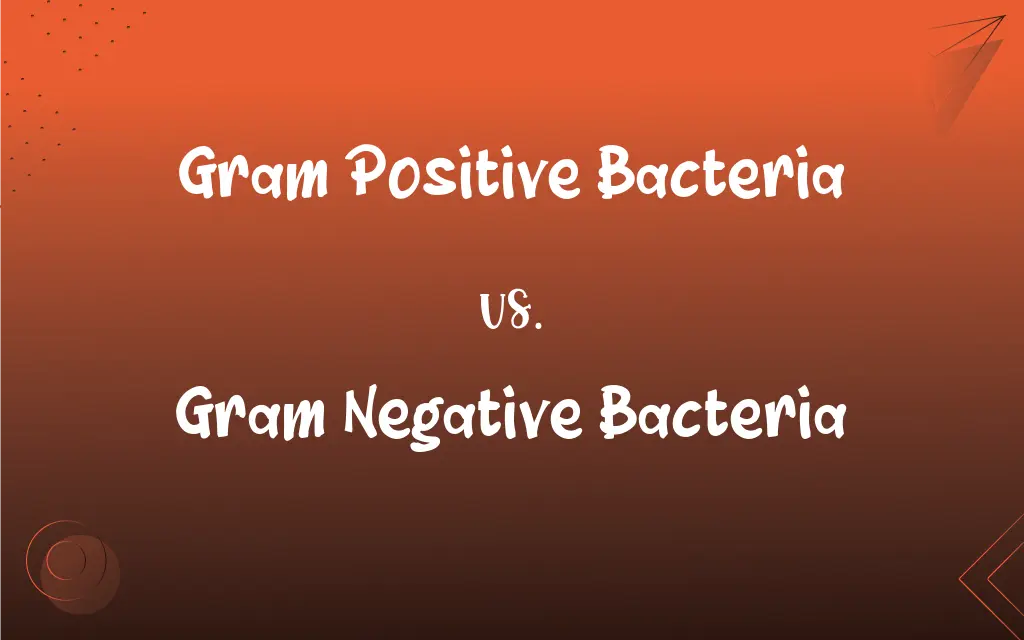Gram Positive Bacteria vs. Gram Negative Bacteria: What's the Difference?
Edited by Janet White || By Harlon Moss || Updated on October 17, 2023
Gram positive bacteria have a thick peptidoglycan cell wall; gram negative bacteria have a thin one and an outer lipid membrane.

Key Differences
Gram positive bacteria have a distinct thick layer of peptidoglycan in their cell walls. In contrast, gram negative bacteria possess a thinner peptidoglycan layer and an additional outer membrane.
When stained with the Gram stain, gram positive bacteria retain the crystal violet dye due to their thick peptidoglycan layer. Conversely, gram negative bacteria do not retain this dye due to their thin peptidoglycan layer and lipid-rich outer membrane.
Gram positive bacteria are generally more susceptible to antibiotics, primarily because they lack the protective outer membrane found in gram negative bacteria. This outer membrane in gram negative bacteria often acts as a barrier to many drugs.
The cell wall structure of gram positive bacteria often makes them more susceptible to lysozyme, an enzyme that targets peptidoglycan. On the other hand, the additional outer membrane in gram negative bacteria offers them protection against this enzyme.
Gram positive bacteria typically produce exotoxins, which are secreted toxins. In contrast, gram negative bacteria often produce endotoxins, which are part of the bacteria's outer membrane.
ADVERTISEMENT
Comparison Chart
Cell Wall Composition
Thick layer of peptidoglycan
Thin layer of peptidoglycan and outer lipid membrane
Gram Stain Result
Retains crystal violet dye
Does not retain the dye, appears pink
Antibiotic Susceptibility
Generally more susceptible
Often more resistant due to outer membrane
Toxin Production
Typically produce exotoxins
Typically produce endotoxins
Vulnerability to Lysozyme
More susceptible
Less susceptible due to protective outer membrane
ADVERTISEMENT
Gram Positive Bacteria and Gram Negative Bacteria Definitions
Gram Positive Bacteria
They are generally more vulnerable to antibiotics compared to their gram negative counterparts.
Penicillin is often effective against gram positive bacteria like Enterococcus.
Gram Negative Bacteria
The presence of an outer lipid membrane characterizes gram negative bacteria.
The outer membrane of Neisseria provides it with resistance, classifying it as a gram negative bacteria.
Gram Positive Bacteria
Gram positive bacteria lack an outer lipid membrane.
The lack of an outer membrane in Bacillus makes it a gram positive bacteria.
Gram Negative Bacteria
They often exhibit resistance to antibiotics due to their outer membrane.
The antibiotic resistance of Pseudomonas aeruginosa is a challenge, stemming from its gram negative nature.
Gram Positive Bacteria
Gram positive bacteria are those with a thick peptidoglycan cell wall.
Streptococcus is a type of gram positive bacteria that can cause throat infections.
Gram Negative Bacteria
In Gram staining, these bacteria do not retain the crystal violet dye.
Salmonella, when Gram stained, appears pink, identifying it as a gram negative bacteria.
Gram Positive Bacteria
These bacteria retain the crystal violet dye in a Gram stain procedure.
After a Gram stain, Staphylococcus appears purple, indicating it's a gram positive bacteria.
Gram Negative Bacteria
Gram negative bacteria possess a thin peptidoglycan layer and an additional outer lipid membrane.
E. coli, found in the gut, is a common gram negative bacteria.
Gram Positive Bacteria
Gram positive bacteria can produce exotoxins.
Some strains of gram positive bacteria, like Clostridium, release harmful exotoxins.
Gram Negative Bacteria
Gram negative bacteria can produce endotoxins.
The fever-causing endotoxins released by some strains of gram negative bacteria like Vibrio are concerning.
FAQs
How do the two differ in Gram staining?
Gram positive bacteria retain the crystal violet dye, while gram negative bacteria don't, appearing pink.
What toxins do gram positive bacteria usually produce?
They generally produce exotoxins.
What about gram negative bacteria?
They typically produce endotoxins.
Which bacteria typically have higher antibiotic resistance?
Gram negative bacteria, mainly due to their protective outer membrane.
What's the main structural difference between gram positive and gram negative bacteria?
Gram positive bacteria have a thick peptidoglycan cell wall, while gram negative bacteria have a thin one and an outer lipid membrane.
Are gram positive bacteria more common than gram negative?
Both are widespread, but their prevalence depends on the environment or habitat.
What's an example of a gram positive bacteria?
Streptococcus is a gram positive bacteria.
Can the classification change for a bacteria over time?
No, gram positive or gram negative classification is based on inherent cell wall structure.
Can both types of bacteria be found in the same environment?
Yes, both can coexist in various environments, including the human body.
Why is treating gram negative bacterial infections sometimes harder?
Their outer membrane often makes them more resistant to antibiotics.
Which bacteria type has a more complex cell wall?
Gram negative bacteria have a more complex cell wall due to the additional outer membrane.
Why are gram stains important?
They help in identifying and classifying bacteria, aiding in medical diagnosis and treatment.
Which type is more susceptible to lysozyme?
Gram positive bacteria are more susceptible.
And an example of a gram negative bacteria?
E. coli is a gram negative bacteria.
Are there beneficial gram positive and gram negative bacteria?
Yes, many bacteria, like certain Lactobacillus (gram positive) or E. coli strains (gram negative), are beneficial.
How do bacteria become resistant to antibiotics?
Through genetic mutations or acquiring resistance genes, more commonly seen in gram negative bacteria.
Can the gram staining technique fail?
While rare, some bacteria might not fit neatly into gram positive or gram negative categories due to atypical cell wall structures.
Do all antibiotics work on both types?
No, some antibiotics are more effective against gram positive bacteria and others against gram negative bacteria.
Do both bacteria types cause diseases in humans?
Yes, both can be pathogenic and cause diseases.
Are gram positive bacterial infections easier to treat?
Generally, yes, because they lack the protective outer membrane that gram negative bacteria have.
About Author
Written by
Harlon MossHarlon is a seasoned quality moderator and accomplished content writer for Difference Wiki. An alumnus of the prestigious University of California, he earned his degree in Computer Science. Leveraging his academic background, Harlon brings a meticulous and informed perspective to his work, ensuring content accuracy and excellence.
Edited by
Janet WhiteJanet White has been an esteemed writer and blogger for Difference Wiki. Holding a Master's degree in Science and Medical Journalism from the prestigious Boston University, she has consistently demonstrated her expertise and passion for her field. When she's not immersed in her work, Janet relishes her time exercising, delving into a good book, and cherishing moments with friends and family.






























































